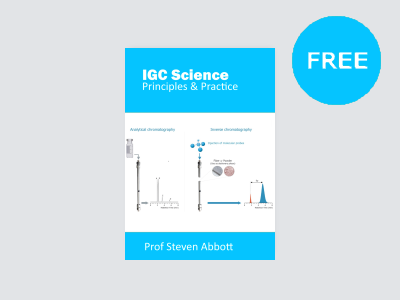Formulation Scientist's Toolkit
This smart toolkit gives you what you need to solve a wide range of formulation issues. You can explore via Products, via Science, or any way that helps you find the set of tools you need.
It's powerful, useful and free, with 500pp, 130 short chapters, links to 100s of the apps on this site.
It's your toolkit, use it the way you want.
Particle Formulation Science: Principles and Practice
Particle formulation is hard, and the commonly-available science is not up to the task. By bringing together a lot of useful science into one book and providing apps and programs to better understand and use the science makes formulation a whole lot easier.
Find out MoreSolubility Science: Principles and Practice
Just 5 key ideas help explain the majority of solubility science: Ideal Solubility, Hansen Solubility Parameters, COSMO-RS, DLVO and the relatively unknown but powerful Kirkwood-Buff. Focussing only on those things that can be used in the real world, the key ideas are brought to life with links to the Practical Solubility apps.
Find out MoreSurfactant Science: Principles and Practice
Much of what is taught about surfactant science is unhelpful and misleading. The book is based on the key principles that can be used in practice, allowing your surfactant formulation work to be a lot more effective. Even the most complicated formulae and ideas are easy to master because they are available in live apps.
Find out MoreSticking Together: The Science of Adhesion
This is my "popular science" book on adhesion from the Royal Society of Chemistry. So it's an easy read, which meant that I had to work twice as hard to make sure the ideas were both right and readable. But it still conveys the key ideas behind adhesion and even has its own YouTube channel!
Find out More
Printing Science: Principles and Practice
Explore the core ideas behind printing science (including drying/curing and adhesion) before going deeply into offset, flexo, gravure, inkjet, screen, colour science and moiré. The damaging myths about printing are exposed and replaced by the real science. The key scientific ideas are linked to apps that bring them alive at a click of a mouse.
Find out MoreThe Abbott Guide to Rheology
Rheology is something we should be using regularly to guide us through formulation issues. But it is usually far too tricky to understand. With this guide and the apps linked to it, you will more easily find out how to use rheology as a tool to provide deep insights into your formulation issues.
Find out MoreIGC Science: Principles and Practice
Interfacial Gas Chromatography is shaking off its old image and becoming a powerful way to look at (subtle) changes in surfaces of pigments and powders. This booklet shows how to ask the right questions about your surfaces and use the right techniques to get the right answers. It also offers a glimpse of the future of IGC.
Find out MoreNanocoatings: Principles and Practice
Those who want to take advantage of the nanoworld in their coatings must be clear that nano can also bring disadvantages. This book takes a clear view of both the promise and problems and dispenses with nano puffery. The result is a book which uses good science, aided by apps, to make sure you can formulate your way to a succesful nanocoating.
Find out MoreAdhesion Science: Principles and Practice
The science of adhesion is well-established but too-little used because it can be hard to grasp. The book explains the science clearly, using live apps to make even the most complex formula easy to grasp. Readers will be surprised that surface energy is of very little importance and that very often weakness can be a source of strength!
Find out MoreAdventure Stories for Girls
What started as some impromptu exciting helicopter rescue adventure stories for my granddaughter, Ella, ended up as a large collection of increasingly researched stories taking her and her helicopter to floods, fires, exploding volcanoes, to Venezuela, Australia, the Arctic & Antarctic, ending up with a blockbuster adventure on Mt Everest.
By then, Ella was older and wanted something more than helicopters, so "The Professor" invented an anti-gravity spaceship and Ella visited the Moon, an asteroid, Mars and the Hubble Space Telescope.
If you have a girl in your life who would like such adventures, with plenty of techie details, (including the tricky aerodynamics of helicopter flight, explained as best I could), then go to the Adventure Stories for Girls page and you can quickly download 100% personalized versions as Word docs, ready for reading and customizing as you wish.
A lot of the fun was adding images to the Word document after telling each story, so your personalized version comes without images, ready for you and the girl in your life to draw or download images.











